
While genetics, age, and health conditions contribute to your diabetes risk, a 2021 review of research published in the British Medical Journal suggested nutrition plays a principal role in preventing, managing, and even reversing diabetes.
Still, that doesn’t mean you need to follow an ultra-limited diet, explains Natalie Allen, RD, clinical assistant professor of biomedical sciences at Missouri State University. One key to reducing diabetes risk is simply making sure you’re getting enough of the right foods.
Allen and other nutrition experts specializing in diabetes prevention and management tell The Healthy @Reader’s Digest which foods can work best to lower your diabetes risk—and how you can balance your diet for blood sugar control with fewer restrictions.
Get news from The Healthy in your inbox each day
Nutrition for diabetes prevention and management: your cheat sheet
There are three main macronutrients to consider when it comes to diabetes—carbohydrates (which includes sugar), proteins, and fats. “The biggest mistake I see is avoidance of carbohydrates,” says certified diabetes educator Erin Palinski-Wade, RD, CDE, LDN, CPT, who is also the author of 2 Day Diabetes Diet and a consultant for MyFitnessPal. “People will severely restrict or eliminate carbohydrates from their diet, which is counterproductive to maintaining a healthy blood sugar value.”
Instead of avoiding carbs, Palinski-Wade suggests you look for complex carbs with high fiber content, like quinoa, beans, and whole grains. (We happen to love this colorful quinoa salad that’s gluten- and dairy-free and loaded with summer veggies—courtesy of our sibling site, Taste of Home.)
Yet no matter which carb you eat, adding some sort of protein will be beneficial, adds Allen. This is because protein takes longer for our body to digest, so the pairing can help prevent blood sugar spikes after eating. Fats work in a similar way—and your body needs its fats. Just try to prioritize healthy fats in your meals.
Further, a 2015 study published in Diabetes Care showed that food order makes a difference—meaning, being conscious of the sequence in which you eat your macronutrients can help balance your blood sugar. For example, the researchers found that if you want to include a starchy carb with your meal, like a potato or white rice, eating a fiber-rich vegetable and healthy protein first can promote better blood sugar levels. (Super clever, right?)
7 Genius Nutrition Hacks a Dietitian Just Inspired Us to Try
Shopping to reduce your diabetes risk
And, the experts say, blood sugar management isn’t all about what you should avoid. In fact, stocking up on the following goodies can help you stay on track with healthy blood sugar and insulin levels.
So, with that, here’s a list of supermarket essentials, from diabetes specialists. Also check out Trying to Quit Sugar? A Diabetes Patient Reveals the One Change That Saved His Life
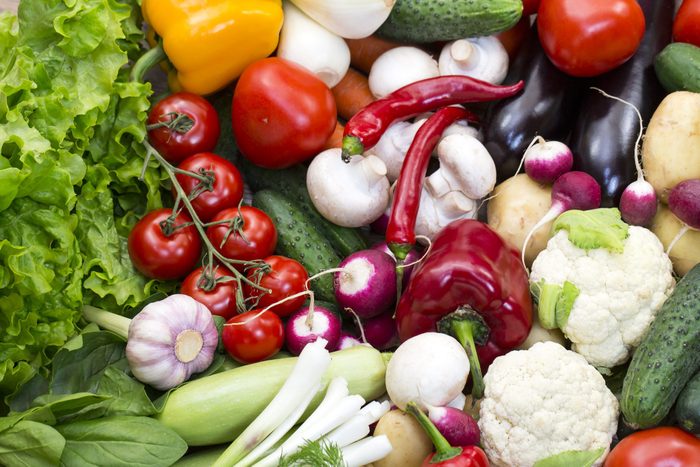
Vegetables
Data shows that most of us don’t eat enough vegetables, Allen says. In fact, a 2017 study published in the Journal of Geriatric Cardiology found that prioritizing plant-based foods in your diet can significantly help prevent and treat type 2 diabetes.
You can’t really go wrong with adding more vegetables to your plate, either, but those with a higher fiber content are ideal for your blood sugar levels. These include spinach and other leafy greens, broccoli, carrots, cabbage, and mushrooms.
11 Benefits of Spinach That Will Convince You to Eat More Leafy Greens
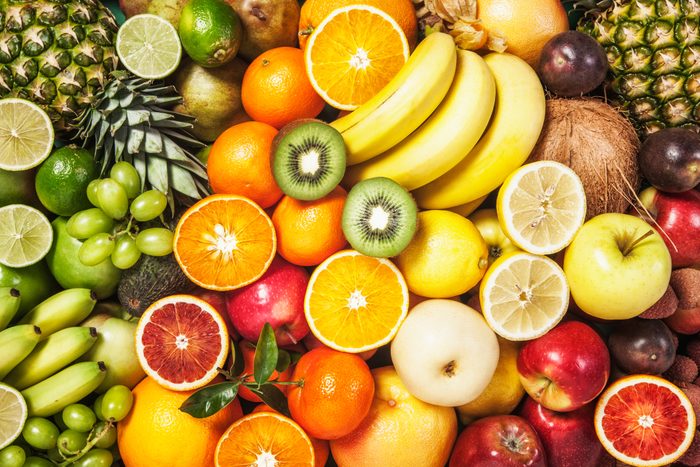
Fruits
Another common myth is that people with diabetes shouldn’t eat fruit. “All fruit has sugar,” Allen explains—but she says most of us aren’t overdoing sugar because of fruit. “Having fruit in your diet has so many health benefits, like antioxidants, vitamins, and soluble fiber.”
A 2013 study published in the BMJ pointed to berries, grapes, and apples as the best options associated with a lower risk of type 2 diabetes. Allen emphasizes one caveat: eat your fruit whole and limit juices or fruit-only smoothies. These can raise your blood sugar quickly. Read our newly published 9 Surprising Foods That Can Wreak Havoc on Your Blood Sugar
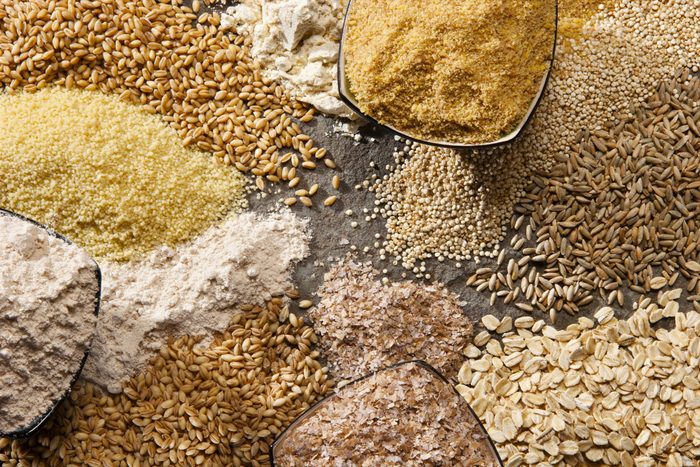
Grains
“Whole grains have a little bit more protein than a refined white product,” Allen says. “That’s going to give you a more stable blood sugar level because it takes longer to metabolize and digest [whole grains].”
A study published in Circulation spells out this effect: diets rich in whole grains protect against diabetes, while refined carbohydrates (such as white bread) increase someone’s risk. Palinski-Wade specifically recommends steel-cut oats as a great, high-fiber pantry staple. “These can be used as a nutritious swap for cereal, bread crumbs, or even ground down as a replacement for flour.” Other items for your grocery list include high-fiber cereals, brown rice, and whole-grain crackers.
Save room for chia seeds in your cart, too. Palinski-Wade says that these tiny whole grains are packed with fiber, and you can toss them into almost any meal. Read 8 Chia Seed Pudding Recipes Nutritionists Love
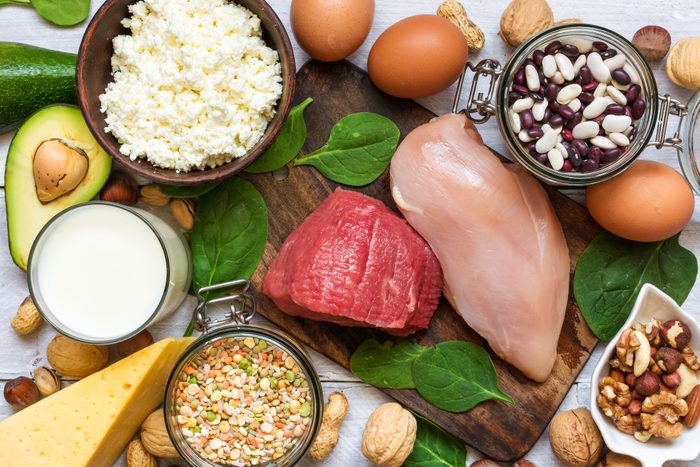
Protein
“Eating protein with carbohydrates helps release steady energy in your body,” Allen says. For example, she says berries or crackers are great for snacking—but adding a protein like Greek yogurt, peanut butter, or cheese makes them even better. This same rule of thumb applies to meals. “If you’re going to have pasta, just make sure you have a protein with it,” Allen suggests.
Research published in the British Journal of Nutrition found that a diet high in plant-based proteins, like beans and legumes, quinoa, and tofu, was associated with a 35-percent lower type 2 diabetes risk. The study also found that eggs are a diabetes-friendly protein option.
If you want to include animal protein in your diet, opt for lean meats like chicken and turkey. Limit red and processed meats to every once in a while.
Here’s What Happens to Your Skin When You Stop Eating Meat, Say Diet and Dermatology Experts
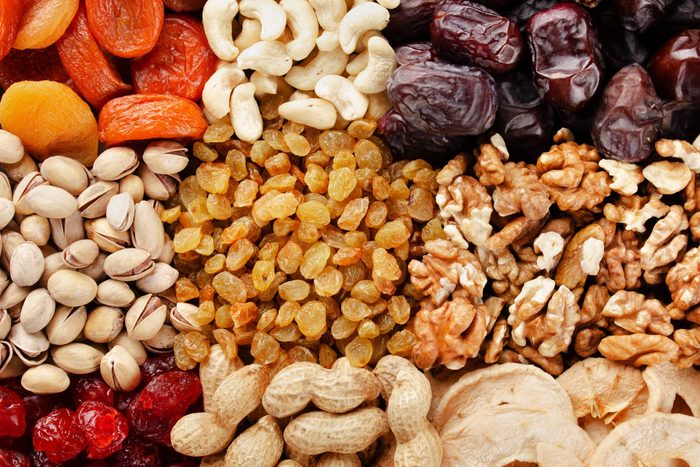
Snacks and sweets
“I am a believer in ‘all food fits’ when it comes to someone’s diet,” says Daniela Novotny, RD, senior instructor of biomedical sciences at Missouri State University.
A review of 48 studies published in JAMA agrees, explaining that, on average, diets based on food restrictions aren’t sustainable. So forming diabetes-friendly eating habits can and should include satisfying your sweet and salty cravings, as long as it’s in moderation.
Novotny recommends keeping around snacks like air-popped popcorn and homemade granola (with nuts, seeds, and chocolate chips for that sweet fix). Other blood sugar-friendly “junk food” items the experts suggest: string cheese, dark chocolate, pistachios, peanuts, pretzels, jerky, and chia pudding. Just remember to exercise portion control—and where possible, add a touch of fiber and protein to snack.
Another winner? Cauliflower crust pizza—Shop the 5 Best Cauliflower Pizza Crusts, Recommended by Registered Dietitians.
Get The Healthy @Reader’s Digest newsletter for what’s trending in health and wellness daily. Follow us on Facebook, Instagram, and Twitter, and keep reading:
- The 5 Best Hormone-Safe Sunscreens, Recommended by Doctors
- Rob Lowe Gets Candid about Fatherhood, Fitness, and the Diet That’s Been a ‘Very Good Fit’
- Dermatology Pros Just Listed Their 6 Favorite Vitamin C Serums
- Here’s How Long the Best Nap Lasts, a Neuroscientist Says
- Tiffani Thiessen Reflects on Her Grief After Losing 3 Iconic Co-Stars: ‘Life Is Extremely Precious’
